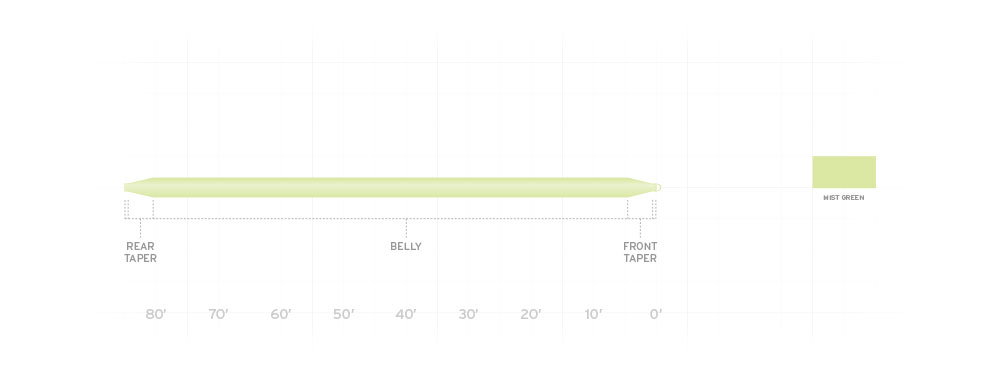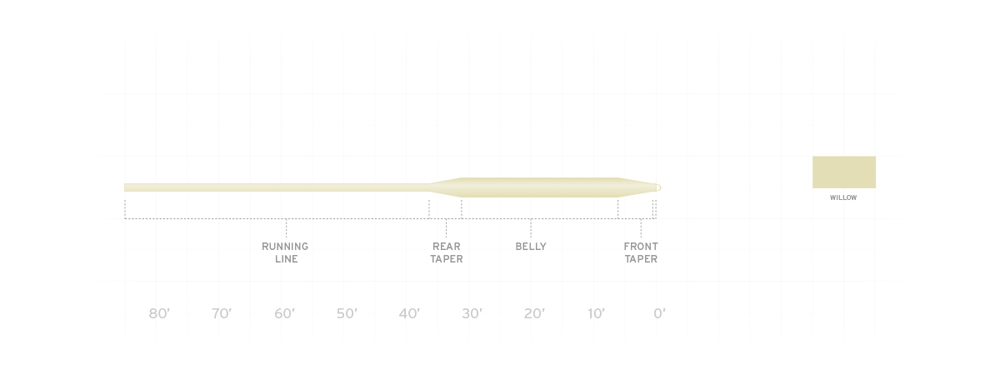Understanding Fly Line Tapers August 24, 2021 – Posted in: Fly Casting, Instruction – Tags: fishing, fly fishing, fly line, fly line casting, fly line tapers, flyfish, flyfishing, flyline
We know that in fly casting we are throwing the weight of the line and our lure, the fly, just goes along for the ride. The rod matches the weight (mass) of the line we are casting. The profile or shape of the line has significant influence on how the fly is carried and presented to the fish.
The fly line “taper” refers to the overall shape of the fly line. Let’s take a look at the different components that make up the taper of a fly line. The belly is the main part of the line where most of the mass is located. The rear taper is the transition from the thin running line to the belly. The front taper is the transition from the belly to the tip. The section of the line that includes all of these parts is called the head.
By varying any of these components, the performance of the line is influenced. There are lines made for general usage, that will cover a wide range of situations. However, with more sophisticated manufacturing equipment available, modern fly lines can be made for very specific applications by adjusting taper components during the manufacturing process.
Fly lines are built in two general taper designs. Double Taper lines (Figure 1) are an older profile that is still in limited use today. These lines have a long main belly with a front taper to the tip that is identical on each end. Today, they are used primarily for light-line, short-range dry fly fishing. These lines excel at accuracy, roll casting, mending, and fly presentation. They perform poorly for distance, dealing with wind, or trying to turn over an air-resistant fly.

Figure 1- Double Taper Line
The extended belly on the double taper line enhances the stability of the line in the air allowing multiple false casts to be made to dry a fly and line up the cast. With more mass of line on the water it is easier to mend and control drift. Roll casts are also easier to make. A lengthened front taper to tip gives a delicate delivery of the fly on the water.
Another aspect of double taper lines is with both ends being identical, the line can be reversed if the part in use wears out or is damaged. This was more of a consideration when fly lines did not have today’s longevity. With a minimal amount of care, modern fly lines have quite an extensive life span.
The vast majority of lines in use today are Weight Forward designs (Figure 2). Here the primary mass of the line is pushed forward on the length of the line. We see two main parts, the head and the running line. The mass of the head carries the fly and pulls the nearly weightless running line along with it. This is the main concept of casting.

Figure 2- Weight Forward Line
The various components of the head are then adjusted as required to create the desired effect. For example, the belly can be built overweighted to carry a larger, more-air resistant fly or to push the fly into the wind easier. Shortening the front taper will help turnover the leader and fly more efficiently. Shooting the line is also easier as it loads the rod quickly with minimal false casts. These types of lines are usually seen in warmwater and saltwater specific designs where fly size or wind are important considerations.
In another application, lengthening the belly and extending the rear taper allows more line to be carried on the back cast and gives a more accurate final presentation. The extended rear taper also makes mending easier and gives more control to the line when on the water. We often see these features on lines specific to nymphing or for steelhead and Atlantic salmon.
We can also structure lines for very specific applications. Modern lines for bonefish have a unique combination of features to help increase angler success. The belly of the of the line can be made overweight to perform better in wind. Lengthening the rear taper allows for a more accurate delivery to the fish, while extending the front taper gives a more delicate presentation to spooky bonefish on shallow flats. Finding the right mix of these features to give maximum performance on the water is critical.
In summary, there are three primary things that influence fly line taper design and performance. The length of the front taper determines the delivery of the fly. A long front taper with a small tip diameter delivers the fly delicately with minimal disturbance. A short, heavy front taper gives a quick, aggressive turnover and is best for larger, more air-resistant flies.
The head length determines how much line can be carried during false casting and how easy it is to mend of control on the water. A long head length gives better accuracy, longer distance and better line control. A short head length is used for quick, short-range casts with minimal false casting.
The physical weight or mass of the line determines the size of the fly that can be cast. The larger or more air-resistant the fly is, the heavier the line needs to be. A heavy line can still cast a small fly such as for bonefish or tarpon. A line that is too light simply is unable to carry a fly with air resistance.
Scientific Anglers offers lines for nearly any fly-fishing scenario imaginable. Selecting the right line can be intimidating and confusing. Understanding fly tapers and taper design is key to selecting the best line for a specific application. Today’s lines are a precision tool and as important, maybe even more important, to fly fishing success than the rod and reel.

2 Comments
Dennis January 19, 2024 - 08:09
“For example, the belly can be built overweighted to carry a larger, more-air resistant fly or to push the fly into the wind easier.”
Could you please elaborate on this advice, as I find it counterintuitive. Here is the reason I find it counterintuitive: If I use a rod designed to cast 210 grains (better than other weights), and I need more power to carry a heavier/more wind resistance fly into headwind, wouldn’t I be better off casting a 280 grains fly line head on a rod designed to cast 280 grains, rather than a 280 grains fly line head on the rod designed to cast 210 grains?
Further, wouldn’t I be better off (or at least less confused) casting a 280 grains fly line head on a medium-fast action rod designed to cast 280 grains, rather than on a super fast action rod designed to cast 210 grains (by experts only)?
S A January 23, 2024 - 17:50
Fly rods, especially modern ones can handle a wide variety of weights, not just one. For example, the AFFTMA standard for fly lines only dictates the weight of the first 30’ of the line. Adding or subtracting 5’ from that distance will change the weight. A 210 grain AFFTMA line is only 210 grains at 30’. It’s probably closer to 240 grains at 35’ and 185 grains at 25’. So you can’t say a rod is optimized for one weight unless you only cast one specific length of fly line.
To answer your questions directly, you could do either, over line a small rod or use a larger rod with a standard line if you struggle casting a large/air resistance. The over lined rod is generally easier for a novice to cast because the deeper bend opens up the casting arc which can impart more energy to the line with less force. It also gives a wider tolerance on timing of the cast. Similarly, a slower action rod with a standard line provides a deeper bend that would be better suited to a novice caster. It really depends on your casting skill.